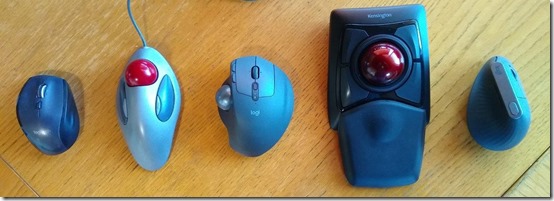Mice can be a pain. In particular, a computer mouse can cause repetitive stress injury to your hand, wrist, and arm.
Logitech M705 Marathon Mouse
I was starting to experience pain in my forearm from using the $50 wireless Logitech M705 Marathon mouse pictured far left.
Logitech Trackman Marble
So I dug my old $30 wired Logitech Trackman Marble out of the cabinet (second from left). This relieved the repetitive stress pain (no longer was my arm tensed as I moved the mouse around) and worked well for several months. However with the onset of winter, I found my dry fingers were sometimes sliding across the “marble” (trackball) without turning it. I had to get my fingers wet to create enough friction to turn the ball. I decided to explore some additional ergonomic options.
Logitech MX Ergo Trackball
The $100 Logitech MX Ergo Trackball (center in picture above) has a smallish, thumb-operated trackball. The whole thing can tilt 20 degrees to the right, which helps avoid wrist strain.
I couldn’t get used to it. Moving the cursor accurately with just the thumb feels awkward, and it takes a lot of spinning to get the cursor to go across my three screens. I also had trouble with the buttons. I think this was because the device is wide enough to provide a nice rest for three fingers, so I kept wanting to use my ring finger as the right-click. However the buttons are under the index finger and the middle finger, so pushing with the ring finger does nothing. To its credit, it does have a scroll wheel, something I miss on the Trackman Marble.
Kensington Expert Trackball
The $100 wireless version of the Kensington Expert Trackball is highly recommended by some reviewers of ergonomic pointing devices. It’s shown above with the included wrist pad attached. This thing is massive; someone said it looks like it could take any of the others in a fight. The large trackball is pretty accurate and easy to use; its pool-ball size lets it swoop across the screens quickly. I don’t seem to be having as much trouble with my fingers slipping off the ball. The ring around the ball acts as a scroller, a nifty idea that I think I could get used to.
The main problem with this device is the buttons. As a right-hander, I set the lower left button to be Left Click, so I could click it with my thumb, and the upper right button to be Right Click, which I click with my ring finger. It’s a bit awkward if you need to hold down the right-click and scroll (e.g. when you want to Copy, not Move, a file in Windows Explorer). That could be said of any trackball, but seems more pronounced with this one. The worst issue, though, is the squishiness and unresponsiveness of the lower left button. I frequently found myself having to click two and three times just to achieve a single click. Double-clicking often leads to a single click. I could probably train myself to make my clicks more deliberate and better centered on the button, but should I have to do that?
Another annoying quirk is that the device loses its connection when the computer goes to sleep. Or maybe the trackball itself has an independent sleep mode. I’ve found that to get the trackball to start responding again, I have to pick it up, turn it over (don’t let the trackball fall out), turn it off and on, set it back right side up, and then move the ball.
Logitech MX Vertical Mouse
The $100 Logitech MX Vertical Mouse, far right above, is basically just a mouse tilted up so the buttons are on the right face. You still push it around on the desk to move the cursor. It’s way overpriced—it should be in the range of the M705—but it may be closest to a solution for me. (Maybe Bluetooth raises the price, but I don’t need that.) Keeping your hand in a “handshake” posture is probably better for your wrist. At first, it’s hard to get used to; it feels like you have to move your whole arm around to position the cursor, less accurate than twisting your wrist a fraction of an inch. I would sometimes position towards an item, miss it, and have to slowly reposition to be over it. But my accuracy seems to be improving as I get used to it. I can span my three screens with about three inches of horizontal movement. The scroll wheel works fine.
I have had some issues with the device losing connectivity at random intervals. Maybe because I have multiple Logitech devices using the same receiver? Turning the mouse off and on gets it reconnected.
Update June 1, 2020 After several months of use, I’m still pretty happy with this mouse. I still use wrist and arm movements much like a regular mouse, but my hand is more vertical and I haven’t had the forearm pain I was getting into with the M705. I haven’t had it lose connectivity in a long time so that is somehow fixed, even through I still have the M705 on the desk and turned on.
Conclusion
I use a pointing device all day long and it’s worth spending some money to make that as comfortable as possible. At this point, I’m thinking I’ll probably go with the MX Vertical Mouse for routine use, but leave my trusty Trackman Marble plugged in for when I need to do more fine-tuned pointing and mousing.

